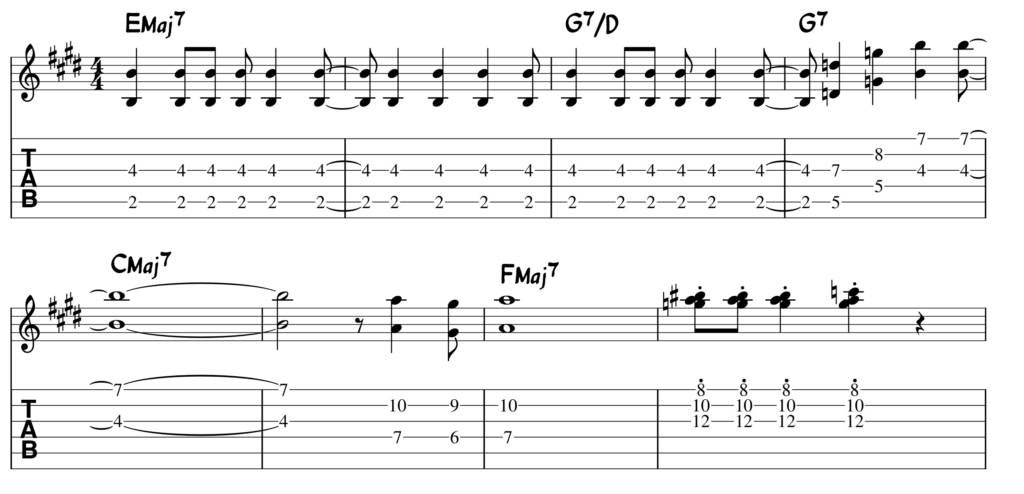Wes Montgomery is the most influential Jazz guitar player of all time. He is showcasing his allround talent here with a nice arrangement of the Jazz-Standard “Here’s That Rainy Day” in the Bossa Nova style.
The Analysis
Wes Montgomery heavily modifies the original song – the most important changes are:
- Key Transposition from G-Major to E-Major
- Re-Phrasing of the melody to fit the Bossa Nova rhythm
- Re-Harmonization of some chord progressions
- Adding an Interlude before and after solos
Key Change and Melody
It is pretty common to change the key of a song for a solo guitar arrangement. Open string bass notes, pretty chord voicings and a good range on the guitar neck are among the desired effects. None of these are of real importance in Wes Montgomery’s arrangement, so it is uncertain why he chose to play the song in E-Major. Maybe he came up with the E-Phrygian Interlude (see below) at first and only then decided to tailor the arrangement around it.
The re-phrasing of the melody adds a nice flow to the arrangement and is partly necessary to comply with the Off-Beat-Phrasing that is typical to Bossa Nova music. Montgomery also elongated the form, it is twice as long as the original song. This makes sense because “Here’s that rainy day” is usually played as a ballad instead of the more flowing Bossa Nova rhythm. The beautiful melody would have to be played way too quick if left in the original form.
Here you can see the first four bars of the original melody in comparism to Wes Montgomery’s arrangement:
Original

Wes Montgomery

Re-Harmonization
The arrangement mostly stays true to the original harmony, but Wes always has some nice ideas. First of all, he adds a common Guide Tone Line to the II-V-I-progressions. The Line moves chromatically from the root of the IIm-chord to the third of the V7-chord. It appears over F#m7 to B7 as well as Am7 to D7 and can be harmonized in several ways:
F#-Minor to B7
Starting on th F#-Minor Chord the following tone F is harmonized with C#7 (the dominant chord to F#m) going back to F#m7 (the Guide Tone here is E) and resolving to B7 (D#).

A-Minor to D7
You can harmonize the same Guide Tone Line (here it is A-G#-G-F#) with an Minor-Major7-chord instead of the Dominant7-chord:

These are rather embellishments than re-harmonizations but Wes comes up with a more advanced idea at the end of the first melody part:

He changes the usual Dominant7-chord (B7) to a C-Major7-chord a half-step above, but keeping the root note B (the major7 of C). He emphasizes this rather modern sound with a CMajor7-Arpeggio played in his trademark Octave-style. A very creative idea that clearly stands out when you listen to the arrangement!
Interlude
Last but not least Wes sneaks in a little Interlude. It is specifically worth mentioning because he makes use of a Modal Interchange (exchanging the major tonality with the Phrygian mode). He plays triads derived mainly off the E-Phrygian scale.

The triads used are E-Major, F-Major and G-Major. While F and G are triads diatonic to the E-Phrygian scale, the usual E-Minor chord is changed to E-Major. This technique is common in the spanish Flamenco music and you probably can hear the influence when you listen closely. Wes must have liked this sound a lot because he also uses it in his beautiful Solo Guitar arrangement of the Jazz-Standard “I’ve grown accustomed to her face”:
All in all it is a beautiful arrangement that is of course not complete without a dazzling solo improvisation by the master. Here is a Soundslice to read along with the transcription. You can find the PDF to the complete melody as well as the solo transcription to Wes Montgomery “Here’s that rainy day” in the shop.